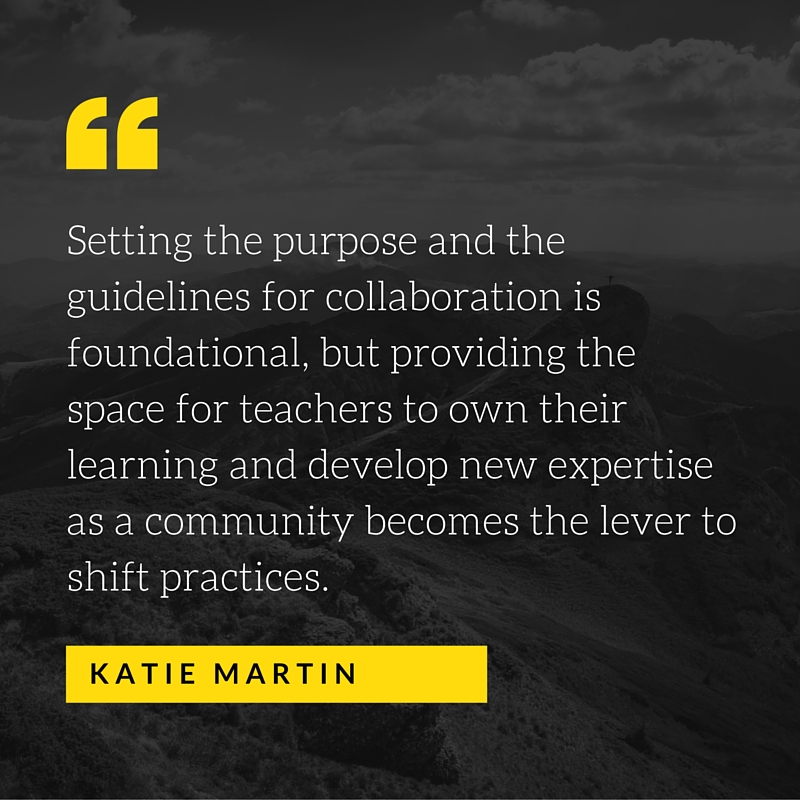As our society evolves and schools work to meet the needs of learners, educators need to develop new skills, knowledge, and mindsets. Working with teachers across diverse has given me insight into how they want to learn and what they want out of their professional learning opportunities. This series will feature a more in depth look at each of the 10 characteristics of professional learning that shifts practices.
Part 1 of this series will focus on ensuring professional learning that is purposeful.
Why is this important?
I have seen and experienced too many learning opportunities for adults and students that adhere to a rigid agenda and content even though it was not meeting the needs of the learners. Similarly, mandated professional development or collaboration without purpose and shared goals can too often be wasted and frustrating. I have heard many complaints from teachers that their time is not always productively used in professional learning, staff meetings, or PLCs, especially when they have a set of externally designed tasks to do without any investment in them. Skilled leaders understand that there is a delicate balance when facilitating powerful learning that requires one to be flexible and adaptable.
David Miyashiro, the superintendent of Cajon Valley Union School District and visionary leader, is keenly aware of this. During a day long collaboration with teacher leaders in his district he ended a session when the presenter failed to facilitate the learning experiences connected the desired outcome. Instead, he repurposed the time to convene working groups and allow the teachers to explore and figure out how to make the program work for them rather than listening to a canned presentation. Before the end of the day news quickly spread that he valued teachers’ expertise and time.
How might we design learning experiences?
It is important to provide opportunities that allow learners to solve relevant issues that matter to them based on the desired goals. I worked with school leaders to shift typical grade level collaborations to be more purposeful. To support teachers, we met with groups of teachers based on their needs, aligned to the school and district goals. We began the day with time for reflecting on their classroom practices and opportunities to share strengths as well as challenges.
The needs of the teachers drove the work for the day and the team determined a specific goal that they wanted to accomplish by the end of the day. As a result, we discovered that there were major gaps in their literacy block. The cross-grade team unearthed some misconceptions, challenges related to schedules, and systems that were not meeting their end goals. This step was critical to ensure investment in the learning process and that the teachers felt their ideas and experiences were valued. Had the objectives been pre-determined, we would have focused on sharing information with teachers and we may have missed the opportunity to get to the heart challenges that were impacting outcomes for students.
To guide the work time, we observed some classrooms and discussed what we noticed. Based on our goals, we set clear targets and some time boundaries to check in on progress. The flexibility fallowed the team to make meaningful decisions about how and what we were learning and ensure it was applicable to their needs.
What might be the impact on educators?
At the end of the day, each teacher shared what they had learned, what they had created, and their actionable next steps. The following reflections spoke to the power of purpose:
The power of the day was the clear purpose and the flexibility to meet our goals.
We appreciate solving problems that matter to us and are not top down.
Both of these reflections highlight the desire to engage in learning activities with clear goals while honoring diverse expertise and experience. When I went back the following week, the teachers had already put into the practice the plans they had created and were sharing what they were learning with their peers. Setting the purpose and the guidelines for the collaboration was foundational, but providing the space for teachers to own their learning and develop new expertise as a community was the lever to shift their practices. The more you empower learners, the more they will be invested in the work. Ultimately, teachers are the ones orchestrating experiences in their classrooms. Therefore, they should be involved in making decisions about what they are learning based on school goal, as well as their needs and those of their students.
This is the part 1 of a 5 part series on the 10 Characteristics of Professional Learning that Shifts Practice. Check out the rest of the series:
Meaningful Problem Solving- Part 2
Moving from Planning to Action- Part 3
Creating Safe Learning Environments – Part 4
Create Your Own Adventure- Part 5



How do you make this happen?